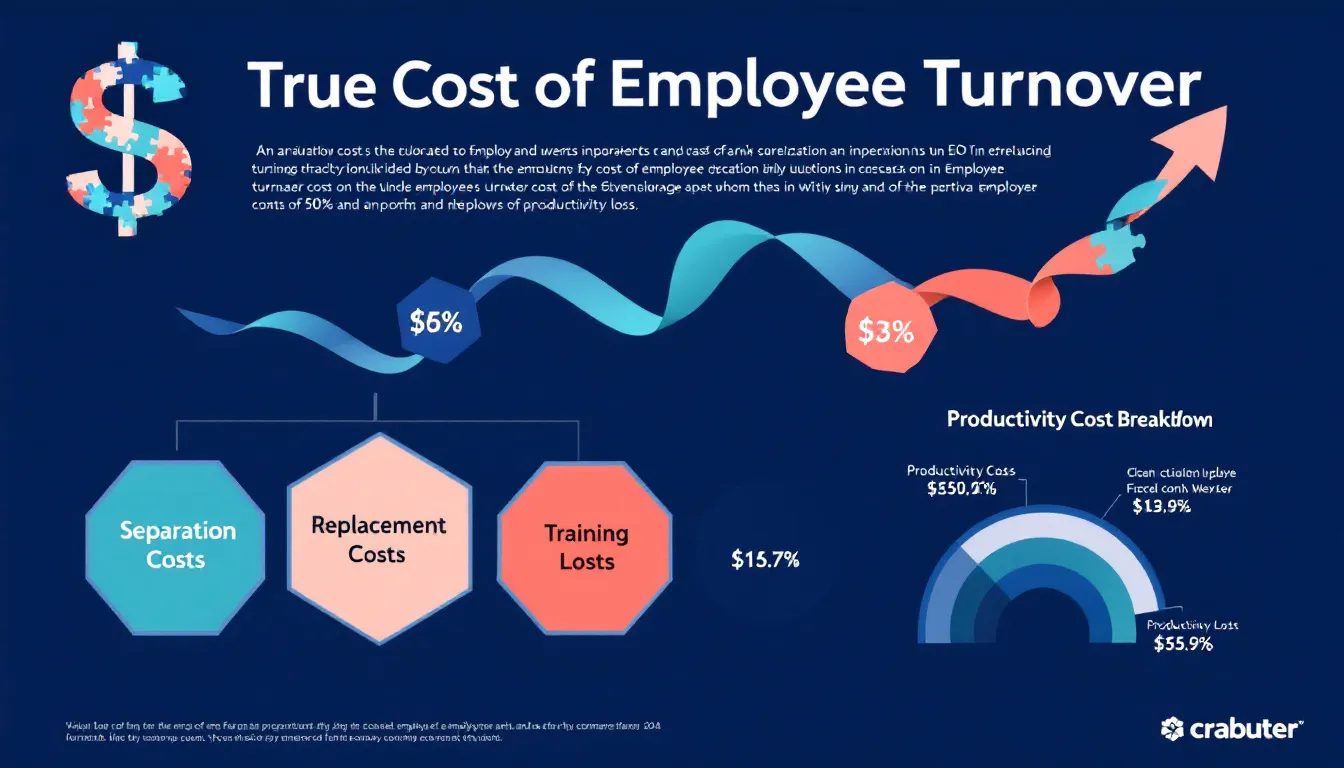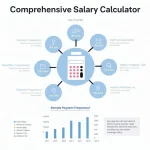Employee Turnover Cost Calculator
Is this tool helpful?
How to Use the Employee Turnover Cost Calculator Effectively
The Employee Turnover Cost Calculator is a powerful tool designed to help businesses quantify the financial impact of losing and replacing employees. To use this calculator effectively, follow these steps:
- Select Currency: Choose the appropriate currency symbol from the dropdown menu (e.g., $, €, or £).
- Enter Employee Salary: Input the annual salary for the position being replaced. For example, enter 75000 for a $75,000 salary.
- Provide Exit Interview Details: Enter the duration of the exit interview in hours (e.g., 1.5) and the interviewer’s hourly rate (e.g., 65).
- Input Administrative Costs: Estimate and enter any administrative expenses related to the employee’s departure. For instance, enter 350 for $350 in costs.
- Include Severance Pay: If applicable, enter the amount of severance pay provided to the departing employee. For example, enter 3000 for $3,000 in severance.
- Specify Vacancy Information: Input the number of days the position is expected to remain unfilled (e.g., 30) and the estimated daily productivity loss (e.g., 250 for $250 per day).
- Enter Temporary Coverage Costs: If you’re using temporary staff or paying overtime, enter these costs. For example, input 1500 for $1,500 in temporary coverage expenses.
- Provide Recruitment Costs: Enter advertising costs (e.g., 750 for $750), agency fees if applicable (e.g., 2500 for $2,500), and background check costs (e.g., 200 for $200).
- Detail Interview Process: Input the time spent per interview in hours (e.g., 1.25), the number of interviews conducted (e.g., 6), and the interviewer’s hourly rate if different from before.
- Specify Training Information: Enter the number of training hours (e.g., 50), the trainer’s hourly rate (e.g., 70), and any costs for training materials (e.g., 600 for $600).
- Estimate Productivity Ramp-Up: Input the number of days it takes for a new employee to reach full productivity (e.g., 75) and the estimated daily productivity loss during this period (e.g., 150 for $150 per day).
- Optional Work Schedule Details: If your work year differs from the standard, enter the number of work weeks per year and hours per week. Otherwise, leave these fields blank to use the default values.
- Calculate: Click the “Calculate Turnover Cost” button to generate the results.
After calculation, the tool will display a breakdown of costs, including separation costs, vacancy costs, replacement costs, training costs, productivity loss, and the total turnover cost.
Understanding Employee Turnover Costs: A Comprehensive Guide
Employee turnover is a significant challenge for businesses of all sizes, often resulting in substantial financial burdens that extend far beyond the obvious costs of hiring replacements. The Employee Turnover Cost Calculator is an invaluable tool designed to help organizations quantify these expenses accurately, providing crucial insights for strategic decision-making in human resources and financial planning.
What is Employee Turnover?
Employee turnover refers to the rate at which employees leave a company and are replaced by new hires. It encompasses both voluntary departures (resignations) and involuntary separations (terminations). While some level of turnover is natural and can even be beneficial, high turnover rates can be detrimental to an organization’s productivity, morale, and bottom line.
The Hidden Costs of Employee Turnover
Many businesses underestimate the true cost of employee turnover, focusing solely on the direct expenses of hiring and training new staff. However, the financial impact is far more extensive, including:
- Separation costs (exit interviews, administrative tasks)
- Vacancy costs (lost productivity, temporary staffing)
- Recruitment and hiring expenses
- Training and onboarding costs
- Lost productivity during the new employee’s learning curve
- Potential impact on team morale and customer relationships
The Employee Turnover Cost Calculator takes all these factors into account, providing a comprehensive assessment of the financial implications of losing an employee.
Benefits of Using the Employee Turnover Cost Calculator
1. Accurate Financial Planning
By quantifying the full cost of employee turnover, businesses can more accurately budget for HR-related expenses and allocate resources effectively. This precision in financial planning can lead to better overall fiscal management and improved decision-making regarding workforce investments.
2. Justification for Retention Initiatives
When management can see the concrete figures associated with turnover, it becomes easier to justify investments in employee retention programs, competitive compensation packages, and workplace improvements. The calculator provides hard data to support these often-overlooked but crucial initiatives.
3. Improved Hiring Strategies
Understanding the true cost of a bad hire can motivate organizations to refine their recruitment processes. This may include investing in more thorough screening methods, improving job descriptions, or enhancing the candidate experience to attract top talent.
4. Enhanced Performance Management
With a clear picture of turnover costs, businesses can better evaluate the return on investment of performance management programs. This can lead to more effective employee development strategies and a stronger focus on addressing issues before they result in turnover.
5. Data-Driven Decision Making
The calculator transforms abstract concepts into concrete numbers, enabling HR professionals and executives to make data-driven decisions about workforce management, succession planning, and organizational structure.
Addressing User Needs and Solving Specific Problems
The Employee Turnover Cost Calculator addresses several critical needs for businesses and HR professionals:
Quantifying Intangible Costs
One of the biggest challenges in assessing turnover impact is putting a number on intangible costs like lost productivity or the impact on team morale. The calculator provides a framework for estimating these elusive expenses, giving users a more complete picture of turnover’s financial impact.
Customization for Specific Roles
Not all positions have the same turnover cost. The calculator allows users to input role-specific data, such as salary, training time, and productivity ramp-up periods, ensuring that the calculated costs accurately reflect the particular position in question.
Long-Term Cost Projection
By factoring in elements like the time to full productivity, the calculator helps businesses understand the long-term financial implications of turnover, not just the immediate hiring and training costs.
Comparative Analysis
Users can run multiple scenarios to compare the costs of turnover across different positions or departments, helping to prioritize retention efforts where they’ll have the most significant impact.
Example Calculations and Practical Applications
Let’s explore a practical example of how the Employee Turnover Cost Calculator can be used to inform business decisions.
Scenario: Mid-Level Software Developer Turnover
Consider a mid-level software developer leaving a tech company. We’ll use the calculator to determine the total turnover cost:
- Annual Salary: $95,000
- Exit Interview Time: 2 hours
- Interviewer’s Hourly Rate: $75
- Administrative Costs: $400
- Severance Pay: $0 (voluntary resignation)
- Vacancy Period: 45 days
- Daily Productivity Loss: $500
- Temporary Coverage Costs: $8,000
- Advertising Costs: $1,000
- Agency Fees: $19,000 (20% of annual salary)
- Interview Time: 2 hours per interview
- Number of Interviews: 8
- Background Check Costs: $250
- Training Hours: 80
- Trainer’s Hourly Rate: $90
- Training Materials: $800
- Time to Full Productivity: 90 days
- Productivity Loss Per Day during ramp-up: $200
Using these inputs, the calculator might provide the following breakdown:
- Separation Costs: $550 (Exit interview + Administrative costs)
- Vacancy Costs: $30,500 ($22,500 productivity loss + $8,000 temporary coverage)
- Replacement Costs: $21,450 ($1,000 advertising + $19,000 agency fees + $1,200 interview costs + $250 background check)
- Training Costs: $14,800 ($7,200 trainer time + $6,800 trainee time + $800 materials)
- Productivity Loss during ramp-up: $18,000
Total Turnover Cost: $85,300
$$\text{Total Turnover Cost} = \sum_{i=1}^{n} \text{Cost Component}_i$$Where cost components include separation, vacancy, replacement, training, and productivity loss costs.
This calculation reveals that the true cost of losing this employee is nearly 90% of their annual salary. Armed with this information, the company might decide to:
- Invest in retention programs for developers, such as professional development opportunities or improved work-life balance initiatives.
- Re-evaluate their compensation package to ensure it’s competitive in the market.
- Improve their onboarding process to reduce the time to full productivity for new hires.
- Develop a strong talent pipeline to reduce vacancy periods and recruitment costs.
Frequently Asked Questions (FAQ)
Q: How accurate is the Employee Turnover Cost Calculator?
A: The calculator provides a comprehensive estimate based on the inputs you provide. Its accuracy depends on the precision of the data entered. For the most accurate results, use actual figures from your organization whenever possible.
Q: Can this calculator be used for all types of positions?
A: Yes, the calculator is designed to be flexible and can be used for various positions across different industries. Simply adjust the inputs to reflect the specific characteristics of the role you’re analyzing.
Q: How often should I use this calculator?
A: It’s beneficial to use the calculator whenever you experience turnover, are considering new retention initiatives, or during annual budgeting processes. Regular use can help track trends in turnover costs over time.
Q: What if I don’t have all the information required?
A: If you’re missing specific data, you can use industry averages or make educated estimates. The calculator will still provide valuable insights, even if some inputs are approximations.
Q: How can I use the results to improve my retention strategies?
A: The breakdown of costs can highlight areas where turnover is most expensive for your organization. Use this information to target your retention efforts, whether that’s improving training programs, enhancing compensation packages, or focusing on workplace culture.
Q: Does the calculator account for differences in industry or company size?
A: The calculator is customizable to your specific situation. While it doesn’t automatically adjust for industry or company size, you can input data that reflects these factors, ensuring the results are relevant to your organization.
Q: Can this calculator help in budgeting for future hiring needs?
A: Absolutely. By understanding the full cost of turnover, you can more accurately budget for both retention initiatives and the expenses associated with hiring new employees when turnover does occur.
Q: How does this calculator account for the impact on team morale and productivity?
A: While it’s challenging to quantify the exact impact on team morale, the calculator includes factors like productivity loss during vacancy periods and the ramp-up time for new hires, which indirectly reflect these less tangible costs.
Q: Is there a benchmark for what constitutes a “good” or “bad” turnover cost?
A: Turnover costs can vary widely depending on the industry, position, and company size. Generally, if the total cost exceeds 50-60% of the employee’s annual salary, it’s considered significant and warrants attention to retention strategies.
Q: How can I use this calculator to justify investments in employee development or benefits?
A: By quantifying the cost of turnover, you can demonstrate the potential savings from reduced turnover rates. Compare the cost of proposed initiatives to the calculated turnover costs to show the potential return on investment.
The Employee Turnover Cost Calculator is an essential tool for modern HR management and financial planning. By providing a detailed breakdown of the various expenses associated with employee turnover, it enables organizations to make informed decisions about their workforce strategies. Whether you’re a small business owner trying to retain key talent or an HR professional in a large corporation looking to optimize your human capital investments, this calculator offers valuable insights that can drive more effective policies and practices. Remember, the goal isn’t just to calculate costs, but to use this information to create a more stable, productive, and satisfied workforce.
Important Disclaimer
The calculations, results, and content provided by our tools are not guaranteed to be accurate, complete, or reliable. Users are responsible for verifying and interpreting the results. Our content and tools may contain errors, biases, or inconsistencies. We reserve the right to save inputs and outputs from our tools for the purposes of error debugging, bias identification, and performance improvement. External companies providing AI models used in our tools may also save and process data in accordance with their own policies. By using our tools, you consent to this data collection and processing. We reserve the right to limit the usage of our tools based on current usability factors. By using our tools, you acknowledge that you have read, understood, and agreed to this disclaimer. You accept the inherent risks and limitations associated with the use of our tools and services.







